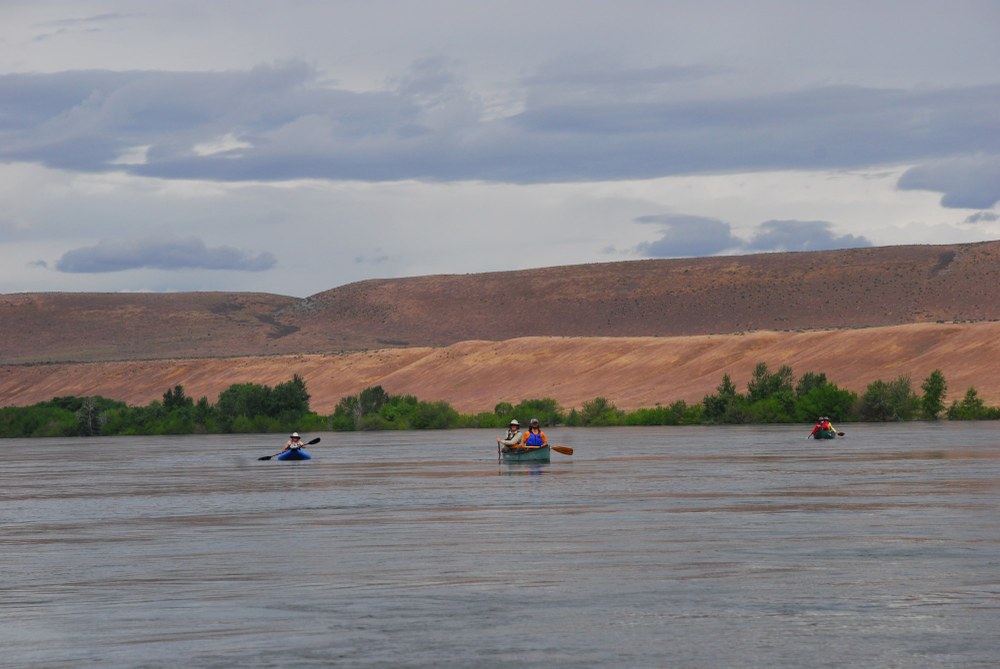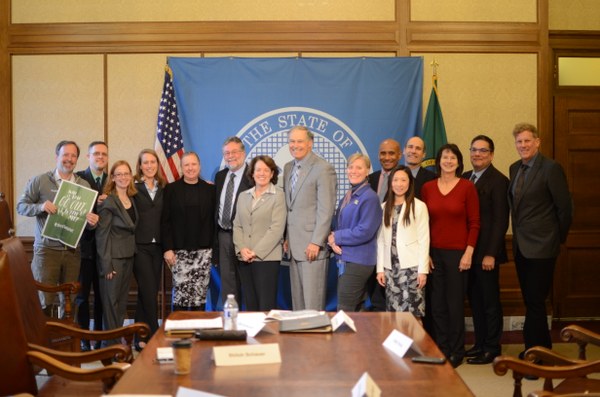
"Protecting wild places has been a part of The Mountaineers DNA from the very beginning. Our members were foundational in the establishment of Olympic National Park and the passage of the National Wilderness Act. We published the book that inspired President Ford to designate the Alpine Lakes Wilderness, and another that chronicled the removal of the ELWAH River Dam. For more than a century, we’ve helped generations fall in love with the outdoors. We get thousands of people outside every year, and in doing so we create strong, authentic connections to these landscapes. These personal connections empower us to defend our public lands."
These words, taken from our recent “Here’s to Wild Places” video, sum up why I jumped at the chance to work for The Mountaineers almost two years ago. Our community is truly unique: we understand the transformational power of the outdoors and are therefore committed to protecting the places where we play. To put it simply, The Mountaineers is about adventure with purpose. This mantra motivates me as I work to amplify our conservation initiatives and help get people outside.
Much has changed in the world of conservation in the short time I’ve been with The Mountaineers. We’ve seen increasing efforts to dismantle and devalue our public lands in an effort dubbed the “Public Lands Heist.” The aggressive and ever-evolving campaign has many facets, but the end goal remains the same: to weaken our public lands until the door is open for privatization. In the case of Washington State, attempts to undermine public lands have recently threatened Olympic and Mount Rainier National Parks and Hanford Reach National Monument.
Current Climate
January 2017 saw the 115th Congress spend its first day in session passing a rules change to make it easier to transfer national lands to states. On a state level, weaker protections can pave the way to privatization. The rules change allows Congress to calculate the transfer as “budget neutral” – essentially calling the land “valueless” – despite the fact that public lands are second only to taxes in generating government revenue.
Since then, we’ve seen legislative proposals such as: the National Monument Creation and Protection Act, which would dismantle the very law that allows presidents to create monuments; the Resilient Federal Forests Act, which would decrease the public’s ability to participate in forest planning and gut environmental assessment processes; and the Federal Land Freedom Act, which would give states control of national lands on the sole condition that states can only use the land for fossil fuel extraction. Administrative actions to decrease public lands access include the Department of the Interior’s unprecedented review of 27 national monuments as well as their recent proposal to increase vehicle entrance fees to $70 in 17 National Parks – a barrier that would nearly triple the cost in Rainier and Olympic National Parks.
These pieces – and many more – should be a red flag for any outdoor enthusiast. While a wacky piece of proposed legislation here and there is nothing new, the sweeping attacks on public lands – through bills, executive orders, bureaucratic maneuvers, and underfunding – are increasing in quantity and sophistication.
Evolving Threats
In 2015, The Mountaineers met with our partners at Outdoor Alliance, a national conservation and recreation advocacy organization, to discuss a disturbing trend emerging in public lands policy. Attempts to sell public lands outright or transfer them to the states were picking up steam.
“We were immediately concerned about how this could impact The Mountaineers’ mission,” said Katherine Hollis, Director of Conservation and Advocacy. “Public lands are where our members hike, ski, climb, and paddle. We felt confident that if outdoor enthusiasts knew about the threats they’d take action.” And our members have. The first blog we shared on the Public Lands Heist is still one of our most read pieces. In 2015, thousands of Mountaineers signed the Public Lands Heist petition, voicing their concerns to policymakers.
The Mountaineers is one of eight member groups helping Outdoor Alliance bring together human-powered outdoor recreationists. When a public lands issue arises the coalition works in concert on policy and advocacy strategy. Each organization can then push a call-to-action out to their members, uniting and amplifying the voices of public lands champions across the country.
In the case of H.R. 621, a bill proposing the sale of millions of acres of public land, Outdoor Alliance helped rally public outcry. Over 4,000 people used Outdoor Alliance’s online platform to write letters, and thousands more called their lawmakers’ offices. Ultimately, the bill’s sponsor withdrew the legislation, saying in an Instagram post, “I hear you and HR 621 dies tomorrow.” Other lawmakers have taken note. One Nevada Congressman gave up on his legislation turning over national lands to the state of Nevada noting, “Transferring millions of acres of public lands … is not something I think the majority of people think is a good idea.”
“Over the last few years, we’ve beaten back the worst, most overt threats to privatize public lands or transfer them to the states,” says Louis Geltman, Policy Director at Outdoor Alliance. “Elected officials at all levels are learning that attacking public lands outright isn’t just bad policy, it’s bad politics.”
But that accomplishment comes with a caveat. Louis goes on to explain that private interests “…haven’t given up on gaining control of our public lands, they’re just changing tactics.”
What Now
“It’s a death by a thousand cuts strategy,” says Katherine. “Because plans to sell or transfer public lands outright caused significant public outcry, we’re now seeing efforts to erode our public lands systems, weakening them until privatization is a viable option.”
The more insidious forms of the Public Lands Heist include: attacking bedrock conservation laws, deterring public access, rolling back public input, and chronically underfunding public lands.
A prime example is the national monuments review, which was kicked off via an Executive Order in April. It opened the possibility of 27 national monuments being reduced or rescinded. The review threatened the recreational access provided by the monuments, ignored the comprehensive public processes that went into creating them, and challenged the Antiquities Act – the law presidents of both parties have used to create national monuments for over a hundred years.
As part of the review, The Department of the Interior opened a 60-day public comment period (far shorter than the years’ long public process that goes into creating a national monuments in the first place).
The Mountaineers and our partners sent out the bat signal, and our members came out in force.
“The great thing about our partnerships is we’re able to bring together so many users,” said Katherine, “In the case of monuments that means a paddler with American Whitewater can speak to canoeing in Washington’s Hanford Reach National Monument, a hiker with the Mazamas can speak to exploring trails in Oregon’s Cascade Siskiyou National Monument, and a climber with The Mountaineers can speak to scaling cracks in Utah’s Bears Ear National Monument.”
The Mountaineers garnered 1,500 comments throughout this review process. Outdoor Alliance printed all of the coalition’s official comments – 8,000 in total – and dropped them off at the Department of the Interior. Nationally, 2.8 million comments were submitted, with 98% of them in favor of keeping or expanding national monument designations.
Despite this, a leaked report from the Department of the Interior revealed recommendations to shrink or alter ten of the 27 national monuments. The Interior did not recommend any changes to Washington State’s Hanford Reach National Monument. At the time of this magazine’s printing, it is unclear how the federal government will act based on the report.
The future is concerning for the ten national monuments listed in the report. However, the recommendations are far from a final course of action.
“The leaked report goes against the millions of comments submitted by Americans, but that doesn’t mean those comments went unnoticed,” said Katherine. “The message is loud and clear: we want to keep our National Monuments. We want to keep our public lands public.”
Leading from the Pacific Northwest
The Mountaineers is in contact with our state’s congressional, senate, and governor’s offices, and meets with elected officials.
“It’s been great to see Washington lawmakers taking a bold stand for public lands,” said Katherine. “They know Washingtonians love the outdoors and that these places are fundamental to our quality of life. Last November, I met with Governor Inslee and had the opportunity to share our concerns about protecting public lands.”
Following the announcement of the national monument review, Senator Maria Cantwell took the senate floor to defend public lands, saying that these kinds of policies “…are harmful to our recreation economy, a disaster for our pristine places, and setting a terrible precedent for future conservation efforts.”
After the recent Department of Interior proposal to raise vehicle entrance fees $70 in 17 National Parks, including Rainier and Olympic which currently charge $25, Governor Jay Inslee wrote a letter to Department of the Interior, warning that the fee “…is a huge spike that will have significant negative impact on Washingtonians and our state’s vitally important outdoor recreation economic sector.”
In the past, The Mountaineers has engaged in bipartisan efforts led by Senators Patty Murray and Maria Cantwell and Congressman Dave Reichert. These projects include successfully expanding the Alpine Lakes Wilderness and working to permanently reauthorize the Land and Water Conservation Fund, the nation’s premiere conservation and outdoor recreation program.
Mountaineers CEO Tom Vogl, says, “At the end of the day, it’s going to take all of us – from citizens to governors, from nonprofits to gear companies. The exciting thing is that in all my time working in the outdoor industry, I’m seeing people come together like never before.”
I, for one, am happy to be a part of it.

Our community stands uniquely at the intersection of recreation and conservation, united by a shared passion for our wild places. Every outdoor enthusiast has a stake in our public lands and we must work together to fiercely protect these places we hold most dear. Only together can we assure that future generations will have equal access to explore and enjoy these places. Places we fiercely defend to keep them just as unique and wild.
This article originally appeared in our Winter 2018 issue of Mountaineer Magazine. To view the original article in magazine form and read more stories from our publication, click here.
 Peter Dunau
Peter Dunau